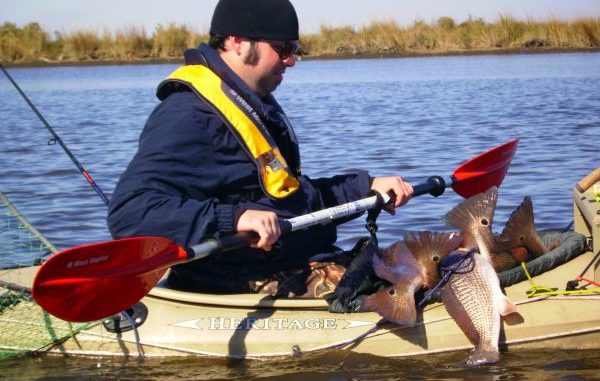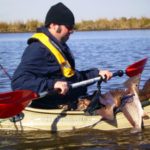
PFDs, float plans should be part of any trip
Kayak fishing is fun, exciting and safe. However, like any outdoor pursuit, especially one involving water, there are some situations that can present danger. Preparation and common sense can help turn a potentially life-threatening incident into nothing more than an inconvenience.
Two tragic kayak-fishing events recently underscore the need for proper precaution. In September 2012, a 32-year-old kayaker went missing near Grand Isle. He was encountered several miles from shore by a commercial vessel and assured the captain that he was fine and in no trouble. Unfortunately, his empty kayak with PFD inside was found, and days of searching failed to locate him. He is presumed dead.
At the end of February, a father and son set out for an afternoon of kayak fishing near Ocean Springs, Miss. They were last seen by a tugboat around 4 p.m., and around 7 p.m. both of their empty kayaks were found by a shrimp boat. All their gear and PFDs were onboard the upright kayaks. The 57-year-old father’s body was found later that night, and authorities searched for several days trying to locate his 22-year-old son. A body believed to be that of the young paddler was found March 8.
In both of these instances, we may never know what actually happened. However, we can be sure that none of these three men set out thinking this would be their final trip. One thing we know for certain is that, unfortunately, none of them were wearing a PFD.
The law simply requires having a PFD onboard and accessible. It does not require you to wear it. However, there’s no guarantee that you will be able to get to it and get it on when you need it most — should you end up in the water.
Most major kayak tournaments are now requiring all participants to wear PFDs to participate.
A PFD is nothing to scrimp on. If it’s uncomfortable, you won’t wear it. If you get one that fits well and allows free movement, you won’t even know you have it on.
There are several styles from which to choose, including traditional foam vests and models that will inflate either manually, automatically or both.
Wearing a PFD is your best insurance against drowning in the event you unexpectedly go for a swim. A small whistle attached to your PFD will help you summon help from anyone nearby.
Since they don’t think they will ever end up in the water, many kayakers don’t practice self-rescue; that is, getting back aboard their kayak from the water. It’s not as simple as it sounds, but with a couple of practice sessions, it is easy to master. Pick a warm time of the year and practice in protected water or a swimming pool.
Whenever possible, always kayak fish with at least one other person. Safety in numbers certainly applies while on the water, and your odds of successfully getting out of a bad situation are much better with a buddy near by.
Make a float plan. If a search becomes necessary, the sooner it begins, the better the chances for a safe outcome. Make sure someone knows where you’re going and when you expect to return. If it’s a last-minute trip, detail your plans in an envelope marked “Float Plan” and put it on your vehicle dash.
The easiest way to end up in trouble is to be caught by bad weather. If a storm is coming, you can’t out run it. You won’t avoid all weather situations, but checking the weather before and during your trip can give you enough notice to seek shelter or abort the trip. Rough seas and dangerous lightening are nothing to play with in a kayak. Additionally, getting soaking wet, even on warmer days, can lead to hypothermia.
Don’t overlook a paddle leash. You can easily forget to mind your paddle while in the heat of battling a fish. It’s a pretty sobering moment when you realize you lost your “motor.”
A handheld, waterproof VHF should always be on board. These radios will get you in communication with the Coast Guard, nearby marine traffic and NOAA weather broadcasts. The best practice is to keep one of these small units attached to your PFD (the one you’re wearing, right?) so it will be close at hand in the event of an emergency.
Cell phones are great to have, also, but should not be your primary means of communication. Many remote areas do not have cell service, and most phones are not waterproof. Keep your phone in a dry box or special case designed to make it waterproof.
Landing fish in a kayak means close encounters with hooks, sharp fins and possibly teeth. Nets or quality lip grips will help you get control of thrashing fish and lessen the chances of getting cut or impaled. No matter how careful, some accidents will be unavoidable.
Additional items to consider include a knife, a signal mirror, drinking water, food, energy bars, dry clothes and a packable rain suit, a first aid kit, waterproof matches or fire starter, a space blanket, cutting pliers, a waterproof flashlight, sunscreen and insect repellant. Each of these may not be necessary for all trips, so plan accordingly.
Kayak space and payload is limited. Make safety gear choices based on your particular location and nature of your trip.
For example, you will likely not need to pack a flashlight or extra food if you are making a short morning trip to a small pond. However, those items would be good to have if you are heading to an area that could find you unexpectedly spending the night.
If it comes down to bringing safety gear or those extra few lures, always opt for the safety gear.
Always assume that boaters do not see you; oftentimes they don’t. Wear bright clothing, fly a safety flag and avoid high-traffic areas, if possible. Yield the right of way even if it should be yours. You will never win in a collision with a powerboat, and there’s no satisfaction in being dead right.
Kayak fishing is nothing to be afraid of, but it’s always a good idea to take a few simple precautions to minimize most risks. As recommended by Ocean kayak fishing pro Jim Sammons, the most important safety gear you can bring along is “common sense.”




